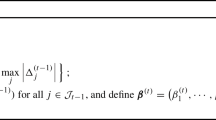Abstract
A new boosting method for a kind of noisy data is developed, where the probability of mislabeling depends on the label of a case. The mechanism of the model is based on a simple idea and gives natural interpretation as a mislabel model. The boosting algorithm is derived from an extension of the exponential loss function, which provides the AdaBoost algorithm. A connection between the proposed method and an asymmetric mislabel model is shown. It is also shown that the loss function proposed constructs a classifier which attains the minimum error rate for a true label. Numerical experiments illustrate how well the proposed method performs in comparison to existing methods.
Similar content being viewed by others
References
Bartlett PL, Traskin M (2007) AdaBoost is consistent. J Mach Learn Res 8: 2347–2368
Bishop CM (2006) Pattern recognition and machine learning. Springer, Berlin
Breiman L (1996) Bagging predictors. Mach Learn 26: 123–140
Breiman L (2001) Random forests. Mach Learn 45: 5–32
Chhikara RS, McKeon JJ (1984) Linear discriminant analysis with misallocation in training samples. J Stat Am Assoc 79: 899–906
Copas JB (1988) Binary regression models for contaminated data. J R Stat Soc Series B 50: 225–265
Domingo C, Watanabe O (2000) MadaBoost: a modification of AdaBoost. In: Proceedings of the 13th conference on computational learning theory. Morgan Kaufmann, San Francisco, pp 180–189
Ekholm A, Palmgren J (1982) A model for a binary response with misclassifications. In: GLIM82: proceedings of international conference on generalized linear models. Springer, Berlin, pp 128–143
Fleuret F (2009) Multi-layer boosting for pattern recognition. Pattern Recognit Lett 30: 237–241
Friedman J (2001) Greedy function approximation: a gradient boosting machine. Ann Stat 5: 1189–1232
Freund Y, Schapire RE (1997) A decision-theoretic generalization of on-line learning and an application to boosting. J Comput Syst Sci 5: 119–139
Hayashi K, Shimizu Y, Kano Y (2008) Consistency of penalized risk of boosting methods in binary classification. New Trends in Psychometrics Universal Academic Press, pp 87–96
Hayashi K (2010, submitted) A simple extension of AdaBoost for asymmetric mislabeled data
Kanamori T, Takenouchi T, Eguchi S, Murata N (2007) Robust loss functions for boosting. Neural Comput, 2183–2244
Kawakita M, Ikeda S, Eguchi S (2006) A Bridge between boosting and a kernel machine, the Institute of Statistical Mathematics Research Memorandum No. 1006, 13
Lachenbruch PA (1966) Discriminant analysis when the initial samples are misclassified. Technometrics 8: 657–662
Lachenbruch PA (1975) Discriminant analysis. Hafner Press, New York
Lebanon G, Lafferty J (2001) Boosting and maximum likelihood for exponential models. In: Advances in neural information processing systems, 11. MIT Press, Cambridge
Lugosi G, Vayatis N (2004) On the Bayes-risk of consistency of regularized boosting methods. Ann Stat 32: 30–55
Malossini A, Blanzieri E, Ng R (2006) Detecting potential labeling errors in microarrays by data perturbation. Bioinformatics 22: 2114–2121
Mason L, Baxter J, Bartlett P, Frean M (1999) Boosting algorithm as gradient descent in function space. In: Advances in neural information processing systems 11, MIT Press, Cambridge
Mease D, Wyner AJ, Buja A (2007) Boosted classification trees and class probability/quantile estimation. J Mach Learn Res 8: 409–439
Murata N, Takenouchi T, Kanamori T, Eguchi S (2004) Information geometry of U-Boost and Bregman divergence. Neural Comput 16: 1437–1481
Rätsch G, Onoda T, Müller K-R (2001) Soft margins for AdaBoost. Mach Learn 42: 287–320
Sano N, Suzuki H, Koda M (2004) A robust boosting method for mislabeled data. J Oper Res Soc Jpn 47(3): 182–196
Shmiovici A, Ben-Gal I (2007) Using a VOM model for reconstructing potential coding regions in EST sequences. Comput Stat 22: 49–69
Takenouchi T, Eguchi S (2004) Robustifying AdaBoost by adding the naive error rate. Neural Comput 16: 767–787
Viola P, Jones M (2001) Fast and robust classification using asymmetric AdaBoost and detector cascade. Neural Inf Process Syst 14: 1311–1318
White H (1982) Maximum likelihood estimation of misspecirfied models. Econometrica 50: 1–25
Author information
Authors and Affiliations
Corresponding author
Rights and permissions
About this article
Cite this article
Hayashi, K. A boosting method with asymmetric mislabeling probabilities which depend on covariates. Comput Stat 27, 203–218 (2012). https://doi.org/10.1007/s00180-011-0250-8
Received:
Accepted:
Published:
Issue Date:
DOI: https://doi.org/10.1007/s00180-011-0250-8




